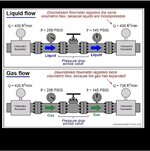l saw this article on LinkedIn, and applying this theory to practical, didn't add up. The way we reduce flowrate to a vessel, either for a liquid or steam is by restricting flow, increasing pressure drop and resulting in a lower flowrate downstream of the valve. ln this case it seems, for liquid it remains the same and for gas it increases!

